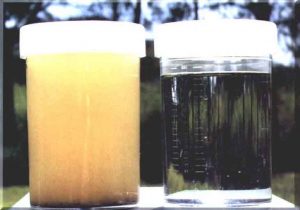Electrocoagulation Vs. Chemical Coagulation
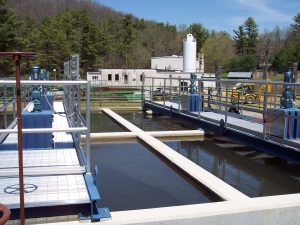
Because Electrocoagulation (EC) utilizes methods that precipitate out large quantities of contaminants in one operation, the technology is the distinct economical and environmental choice for industrial, commercial and municipal waste treatment. The capital and operating costs are usually significantly less than chemical coagulation. It is not unusual to recover capital costs in less than one year.
For example a 5 GPM system contrasts the advantages of Electrocoagulation with a typical chemical coagulation system. This system was designed with the following requirements:
- Reduce Ni from 8.74 to < 3 mg / I
- Reduce Zn from 28.8 to < 3 mg / I
- Reduce TSS from 657 to < 250 mg / I
- Reduce Oil and Grease from 27 to < 15 mg / I
- Reduce phosphorus from 158.75 to < 10 mg / I
- Process flow rate of 5 GPM (1,500,000 GPY)
The estimated yearly operating cost saving using Electrocoagulation in place of chemical coagulation is $43,500.00 per year. This does not include labor, sludge transportation or disposal costs.
A second example is a system with requirements to:
- Reduce Ni from 25 to < 2.38 mg / I
- Reduce Cr from 210 to < 1.71 mg / I
- Flow rate of 100 GPM (30,000,000 GPY)
| Operating cost: | Chemical Coagulation | Electrocoagulation |
| per 1,000 gal | $14.18 | $1.69 |
| per year | $425,400.00 | $50,700.00 |
The estimated yearly operating cost saving using Electrocoagulation in place of chemical coagulation is $374,700.00 per year. This does not include labor, sludge transportation, or disposal costs.
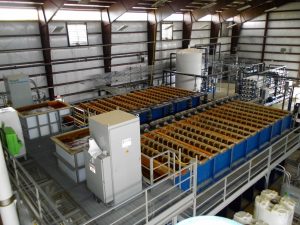
Chemical precipitation in wastewater treatment involves the addition of chemicals to alter the physical state of dissolved and suspended solids and to facilitate their removal by sedimentation. The chemicals used in wastewater treatment include Alum, Ferric chloride, Ferric sulfate, Ferrous sulfate, and Lime. The inherent disadvantages associated with most chemical unit processes (activated carbon adsorption is an exception) is that they are additive processes. (Metcalf & Eddy, Wastewater Engineering Treatment Disposal Reuse, Third Edition, page 301-303). This problem is eliminated in the Electrocoagulation process. These chemicals are not only expensive, but, more importantly, the net increase in the dissolved constituents in the wastewater render it impractical or impossible to reuse.
Electrocoagulation uses electricity to precipitate the dissolved and suspended solids. The total dissolved solids in the liquid usually decrease by 27 to 60 percent. This enables the water to be reused in many applications, such as water reuse in steam cleaning operations. Reuse of the water provides a major advantage because this eliminates all EPA and POTW discharge concerns, to say nothing of the replacement costs of the water itself.
Electrocoagulation produces a cleaner water than either chemical precipitation or sedimentation ( Wastewater Engineering, page 488 ). As discharge requirements become more stringent EC will become more essential.
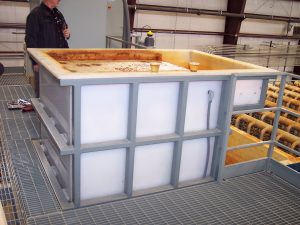
Constituent: Percentage of removal by:
|
Electrocoagulation |
Chemical Coagulation |
Sedimentation |
|
| TSS | 95 to 99% | 80 to 90% | 50 to 70% |
| BOD | 50 to 98% | 50 to 80% | 25 to 40% |
| Bacteria | 95 to 99.999% | 80 to 90% | 25 to 75% |
The handling and disposal of the sludge resulting from chemical precipitation is one of the greatest difficulties associated with chemical treatment. Sludge is produced in great volume from most chemical precipitation operations, often reaching 0.5 percent of the volume of wastewater treated when lime is used. Waste water Engineering, Third Edition, page 489 – 491), estimated the maximal removal of TSS without chemical is up to 60 percent. With the addition of chemicals, ferrous sulfate and lime, TSS removal rates may climb up to 85 percent.
Assume that the following data apply to this situation:
1. Wastewater flow rate = 1.0 Mgal / d
2. Wastewater suspended solids = 220 mg / l
3. Ferrous sulfate (FeSO4 * 7(H2O)) added = 70 lb / Mgal
4. Lime added = 600 lb / Mgal
5. Calcium carbonate solubility = 15 mg / l
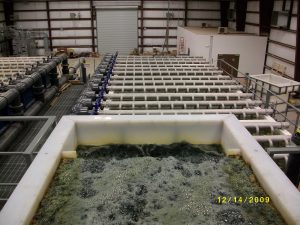
A. 99 percent removal of the TSS with EC will produce: 60 percent of the TSS (with out chemicals) will produce 1,100 lb/ sludge on a dry matter basis (DMB) (Volume, 285 cubic feet / day)
B. 85 percent removal of the TSS, (with the chemicals) will produce 3,042 lb/ sludge (Volume, 619 cubic feet / day)
1) 1,560 lb / d of sludge from the TSS
2) 27 lb / d of sludge from the Ferric Hydroxide
3) 1,455 lb / d of sludge from the Calcium carbonate
3,042 Total lbs of sludge on a dry basis.
C. 99 percent removal of the TSS with EC will produce:
1) 1,817 lb / d of sludge from the TSS
2) 8 lb / d of sludge from the aluminum chambers
1,825 Total lbs of sludge on a dry basis (Volume, 285 cubic feet / day)
The total sludge generated by EC contains less than 0.5 percent added coagulant. Total sludge generated by Chemical precipitation contains 49 percent added coagulant. The added sludge generated by chemical precipitation effectively doubles the sludge disposal volume. The hazardous waste issue may increase the cost 20 to 30 fold.
“When compared with alum treatment, Electrocoagulation provided approximately 83% less sludge volume and a 76% improvement in filtration rate.”
Sludge disposal costs are significant. A Class II landfill in Northern California only disposes or treats non hazardous waste. The landfill charges $18.00+ /- yard tipping fees for Class II land fill, non-leachable solids in the 20% moisture range. Non hazardous waste recyclers in Northern California charge processing fees from $0.45 – $3.00 per gallon depending on solids and / or hydrocarbon content. Hazardous waste tipping fees for F listed sludge in Northeastern Colorado range from $400 to $600 per yard.
Hauling charges are significant and may be more than the tipping fee. Hauling charges range from $55 to $70 per hour for short runs and $2.20 to $2.50 per loaded mile for runs over 100 miles for a 3,500 to 7,000 gallon (10 to 20 Yard) truck. In addition there is a $200 truck washing fee. The hauling savings generated from EC as compared to chemical precipitation is usually more than the cost to operate and maintain the Electrocoagulation system marketed by Raintech.
In example B, above, 85 percent of the TSS was removed with chemicals, producing 3,042 lbs of sludge on a Dry Matter Base (DMB). The volume of this sludge was 619 cubic feet /day, of which 49%, (1,490 lbs DMB totaling 303 cubic feet / 11 cubic yards) came from the added chemicals required to achieve the removal of the TSS. Assuming a two-hour run for a 10-yard truck at $55 per hour with a $200 truck washing fee, the extra hauling cost for chemical added sludge is $310.
Electrocoagulation of oxygenated municipal sewerage water is summarized:
| Constituent |
Raw |
Treated |
% Removal |
| BOD (mg/l) | 1,050 | 14 | 99% |
| TSS (mg/l) | 4,620 | 7 | 99% |
| Bacteria (cfu) | 110,000,000 | 2,700 | 99% |
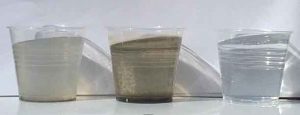
The Electrocoagulation cost was $0.24 / 1,000 gallons for electricity and chamber repair. The Electrocoagulation operating cost is $240.00 per 1.0 MGPD. That is a $70 per day savings ($310-$240) with Electrocoagulation on hauling alone after deducting the Electrocoagulation operating cost.
Electrocoagulation can produce an environmentally friendly sludge in the 6 to 7 pH range. The metals in the sludge at this pH range are stabilized in a non hazardous form as Oxides, that will pass the U.S. Environmental Protection Agency (EPA) Toxic Classification Leaching Procedure (TCLP), and California Title 22 STLC & TTLC leach tests.
Chemical precipitation on the other hand, usually creates a sludge in the caustic pH range above 10. The metals precipitate as hydroxides, a hazardous form because the metals will become soluble again at the natural pH range around 7.
For example chemical precipitation of phosphorus is brought about by the addition of the salts of multivalent metal ions that form precipitates of sparingly soluble phosphates. The multivalent metal ions used most commonly are calcium (Ca++), Aluminum (Al+++), and Iron (Fe+++).
Chemical coagulation necessitates the addition of calcium, usually introduced in the form of lime. As the pH of the wastewater increases beyond 10, excess calcium ions will then react with the phosphate. The quantity of lime required to precipitate the phosphorus in wastewater is typically about 1.4 to 1.5 times the total alkalinity expressed as CaCO3. Because a high pH value is required to precipitate phosphate, the pH usually requires adjustment before the subsequent treatment or disposal.
In the case of alum and iron, 1 mole will precipitate 1 mole of phosphate. These chemical precipitation reactions must be considered in light of the many competing reactions, their associated equilibrium constants, the effects of alkalinity, pH, trace elements, and ligands found in wastewater. Therefore, dosages are generally established on the basis of bench scale tests and occasionally by full-scale tests (Wastewater Engineering, page 308).
When chemical precipitation is used, anaerobic digestion for sludge stabilization may not be possible because of the toxicity of the precipitated heavy metals. (Wastewater Engineering, page 756). For land application of sludge, concentrations of heavy metals often limit the sludge application rate and the useful life of the application site to which it is applied (Wastewater Engineering, page 772).
Land application of sludge has been practiced successfully for decades. Sludge may be applied to (1) Agricultural land, (2) Forest land, (3) Disturbed land, and (4) Dedicated land disposal sites. Sludge acts as a soil conditioner to facilitate nutrient transport, increase water retention, and improve soil tilth. Sludge also serves as a partial replacement for expensive chemical fertilizers. Characteristics of sludge that affect its suitability for land application or affect the design of land application systems include organic content (usually measured as volatile solids), nutrients, pathogens, metals, and toxic organics. (Wastewater Engineering, page 903). EC can eliminate the concerns regarding pathogens, and metals.
Metals are a major concern in sludge as shown in the following table (Wastewater Engineering, page 772). Typical metal content in wastewater sludge:
Dry sludge, mg / kg
| Metal |
Range |
Median |
| Arsenic (As) | 1.1-230 | 10 |
| Cadmium (Cd) | 1 – 3,410 | 10 |
| Chromium (Cr) | 10 – 99,000 | 500 |
| Cobalt (Co) | 11.3 – 2,490 | 30 |
| Copper (Cu) | 84 – 17,000 | 800 |
| Iron (Fe) | 1,000 – 154,000 | 17,000 |
| Lead (Pb) | 13 – 26,000 | 500 |
| Manganese (Mn) | 32-9,870 | 260 |
| Mercury (Hg) | 0.6 – 56 | 6 |
| Molybdenum (Mo) | 0.1 – 214 | 4 |
| Nickel (Ni) | 2 – 5,300 | 80 |
| Selenium (Se) | 1.7 – 17.2 | 5 |
| Tin (Sn) | 2.6 – 329 | 14 |
| Zinc (Zn) | 101 – 49,000 | 1,700 |
EPA concerns about toxic leachable metal build up in soils may cause many sludges to be deposited in hazardous waste land fills. This not only increases the disposal cost several fold, it eliminates the beneficial soil additive effect discussed earlier.
The reality of the Hazardous waste limits can be illustrated by acceptable disposal limits at non hazardous disposal facilities like Forward, Inc. Stockton, CA. Forward, Inc. can only accept waste for disposal with levels of metals below the following leachability listed limits:
| Element | Title 22 STLC (mg/l) | Title 22 TTLC (mg/kg) |
| Antimony (Sb) | 15.00 | 500 |
| Arsenic (As) | 5.00 | 500 |
| Barium (Ba) | 100.00 | 10,000 |
| Beryllium (Be) | 0.75 | 75 |
| Cadmium (Cd) | 1.00 | 100 |
| Chromium (Cr) | 560.00 | 2500 |
| Hexavalent (Cr+6) | 5.00 | 500 |
| Cobalt (Co) | 80.00 | 8,000 |
| Copper (Cu) | 25.00 | 2,500 |
| Lead (Pb) | 5.00 | 1,000 |
| Mercury (Hg) | 0.20 | 20 |
| Molybdenum (Mo) | 350.00 | 3,500 |
| Nickel (Ni) | 20.00 | 2,000 |
| Selenium (Se) | 1.00 | 100 |
| Silver (Ag) | 5.00 | 500 |
| Thallium (Tl) | 7.00 | 700 |
| Vanadium (V) | 24.00 | 2,400 |
| Zinc (Zn) | 250.00 | 5,000 |
Forward has no fixed limit for petroleum hydrocarbons except:
Benzene at 0.5 mg / l (TCLP).
Electrocoagulation may soon move from the optional treatment method to the essential treatment method as the US EPA begins to enforce the laws protecting the environment from toxic wastes, including heavy metals. Electrocoagulation cleans most wastewater streams better, with less operating cost, producing less sludge, with the sludge being a better quality than chemical precipitation. The reuse opportunities for the water is increased because dissolved solids are not added to the waste water stream; and usable products are harvested because the metal oxides pass leachability tests, allowing the sludge to be utilized as a soil additive.
Assume that the following data apply to this situation:
1. Wastewater flow rate = 1.0 Mgal / d
2. Wastewater suspended solids = 220 mg / l
3. Ferrous sulfate (FeSO4 * 7(H2O)) added = 70 lb / Mgal
4. Lime added = 600 lb / Mgal
5. Calcium carbonate solubility = 15 mg / l
